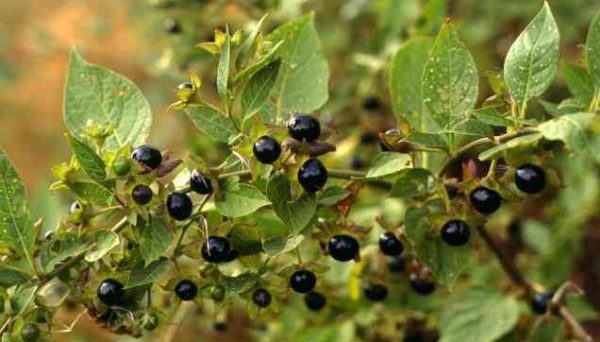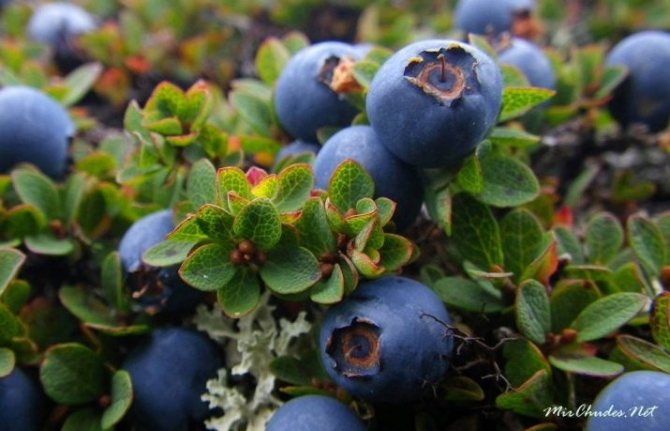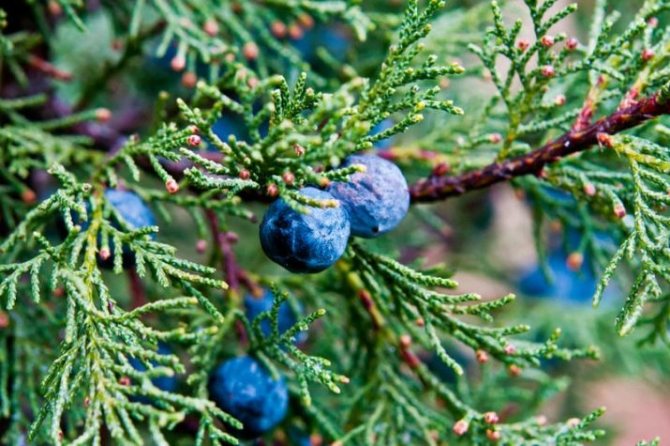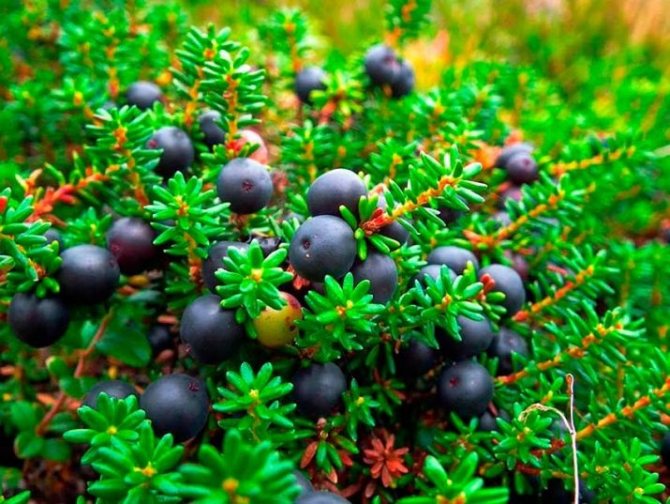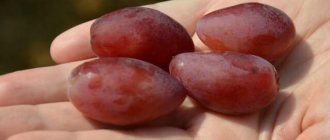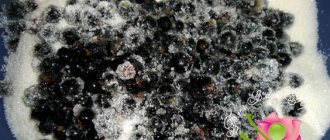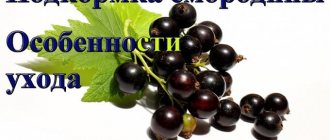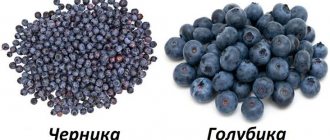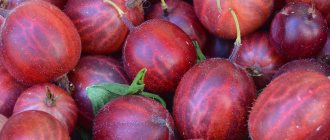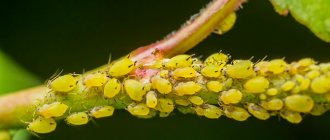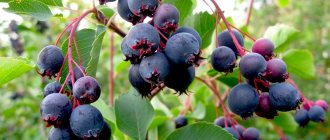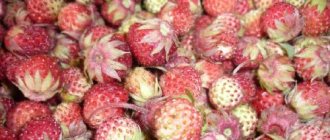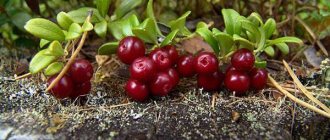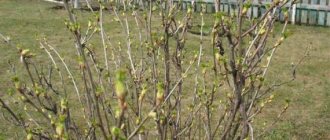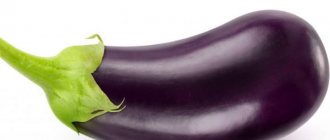One wonderful bush has been growing in my garden for several years. Honestly, I don't remember where and how I came from. This year (well, already last summer), the bush gave out berries for the first time: large black ones to taste - currants, and the shape of the berries is more like a gooseberry. And the leaves on the bush are like gooseberries. I invited my neighbors-experts to tell me what was growing in me. Our council ruled that this is a hybrid of currants and gooseberries. I found an interesting article about this miracle. Suddenly, someone also grows a similar wonderful bush.
Yoshta is a new, unique, high-vitamin, berry crop, a fruit-bearing hybrid of black currant and gooseberry. The name "yoshta" comes from the two German currants and gooseberries.
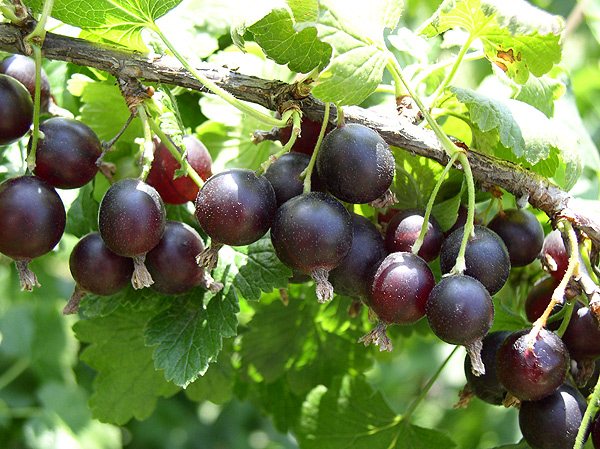
Joshta is the result of many years of work of several generations of breeders who have worked on crossing black currants and gooseberries. Scientists tried to improve the currants in the following parameters: to increase the size of berries and yield, as well as to instill resistance to kidney mites and terry. At the same time, it was desirable to get rid of gooseberry thorns when crossing.
Yoshta is a perennial berry bush. The bushes of this plant are powerful, spreading. They have great vigor of growth and form shoots with a height of 1.5 m and more. The leaves are dark green, large, shiny, and without the aroma of black currant, long non-falling. The flowers are yellow, large and bright. The berries are black, with a purple bloom, have a very dense skin, the size and shape are reminiscent of a cherry. They have a sweet and sour taste and a pleasant nutmeg aroma. Berries are rich in vitamins C and R. In terms of the amount of vitamin C, yoshta exceeds black currant by 4 times. Resistant to winter frost and disease. Partially self-pollinated, but it will be nice if black currants and gooseberries grow nearby for pollination. Fruiting up to 12-18 years. The hybrid is not susceptible to diseases of powdery mildew and anthracnose. His kidneys are not affected by kidney mites. Due to the low probability of disease and damage by pests, yoshta does not require spraying with pesticides and herbal preparations. Since Yoshta grafts are compatible with golden currants, it can be grown in a standard form (stem height 50 cm). The fruiting bush consists of 15-20 branches of different ages, the crown diameter reaches 1.5-2 m. The root system lies at a depth of 30-40 cm. Branches older than 5 years are cut out. The first berries appear in the 3-4th year, and full fruiting occurs in the 4th-6th year after planting. Harvest from a bush, depending on agricultural technology, from 5 to 10 kg or more.
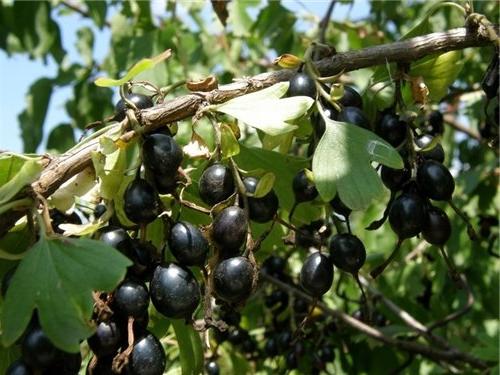

Yoshta requires an open, sunlit area. The greatest yields are obtained on well-cultivated soils rich in organic matter. Prepare the soil for planting in the same way as for currants. You should only take into account the high need for potassium yoshta. To obtain a stable harvest near the yoshta, it is necessary to plant black currants and gooseberries on a bush.
The soil under the crown and near the trunk should be mulched. This creates a favorable water and nutrient regime in the soil, prevents the growth of weeds, and reduces the need for loosening the soil. For mulch, humus or peat is used. One bush requires up to 20 kg of mulch.In the first 3 years, the approximate fertilization rates are annually 4-6 kg of organic fertilizers, 30 g of simple superphosphate, 20 g of potassium sulfate per 1 m2, in the 4th and subsequent years - 4-6 kg of organic fertilizers, 40 g of simple superphosphate and 24 g of potassium sulfate. Yoshta is fed with the same fertilizers and at the same time as black currants. The basic principles of pruning are determined by the relationship of yoshta with currants and gooseberries and are similar to the techniques used for these shrubs.
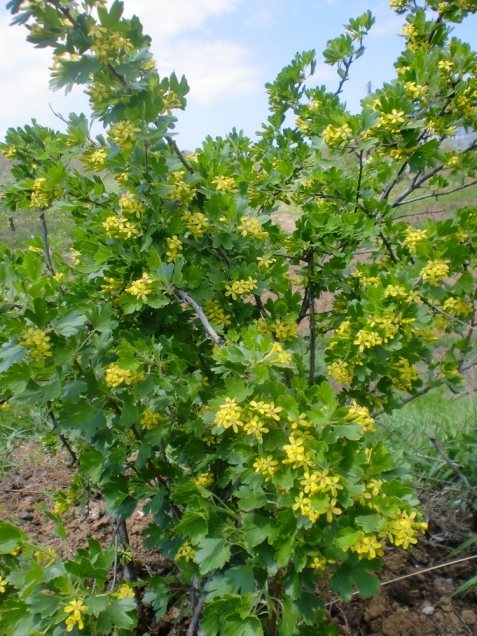

Propagated by cuttings and offspring. Yoshta can be planted in spring and early autumn, although there are claims that the best dates are late August - early September. The minimum distance between bushes is 1.5-2.5 m.
When digging a site under yoshta, up to 400 g of lime, 8-10 kg of organic fertilizers, 100-120 g of simple superphosphate, 80-100 g of potassium sulfate are applied. And when filling the planting pit - 8-10 kg of organic fertilizers, 150-200 g of simple superphosphate and 40-60 g of potassium sulfate. When planting, the distance between the rows is 2 m, in a row - 1.25-1.5 m.The diameter of the planting pit is 60 cm, the depth is 40 cm.
Yoshta berries fully ripen within 2-3 weeks. Berry weight from 2.5 to 7 g (average weight 4.5 g). Since the berries, collected in small clusters, ripen at different times, they can hang on the bush for a long time. In general, harvesting can begin at the end of July, when the fruits reach biological maturity.
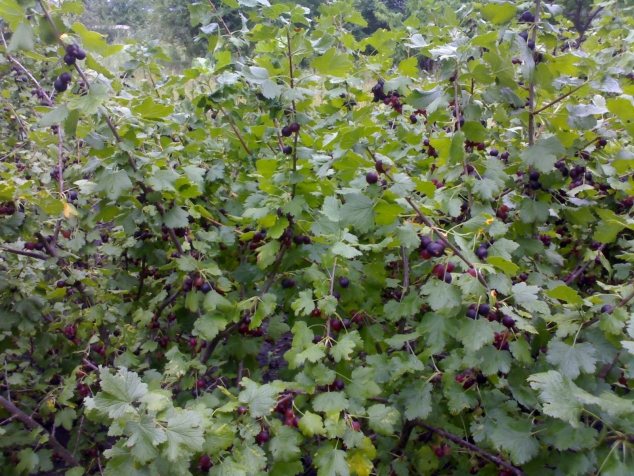

Yoshta berries can be consumed both fresh and processed. It is recommended to take semi-ripe berries for jam (they do not boil over, retaining their shape). Ripe berries are frozen, juices, fruit drinks, compotes, jam, jam, jelly, confitures are prepared from them. These products are prepared in the same way as from regular currants.
Yoshta fruits have medicinal properties - they are used for gastrointestinal diseases, they improve blood circulation and contribute to the elimination of radioactive substances and heavy metals from the body.
| Yoshta | |
| Hybrid origin | |
| Ribes nigrum × Ribes divaricatum × Ribes uva-crispa | |
| Hybrid | |
| Ribes × n> Rud.Bauer & A.Bauer, 1989 | |
Edible berry names
Among the black berries that grow in the garden or in the forest and do not pose a danger to humans, there are both widely known and rare representatives. Most of them contain useful substances and vitamins, and can also be shown in the treatment of certain diseases. They can grow on tree branches - for example, mountain ash, on bushes - currants, or hide in the grass - blueberries. The most popular are currants, honeysuckle, bird cherry and others. What kind of forest and garden berries can you eat and what are their benefits?
Elder
The berry is a natural antioxidant. Its reception removes cholesterol from the body, has a positive effect on the heart and blood vessels, and strengthens the immune system. Experts recommend elderberry for diseases such as tonsillitis and flu, they help well with colds, relieve coughs. In addition, the fruits have antibacterial and antiviral effects.
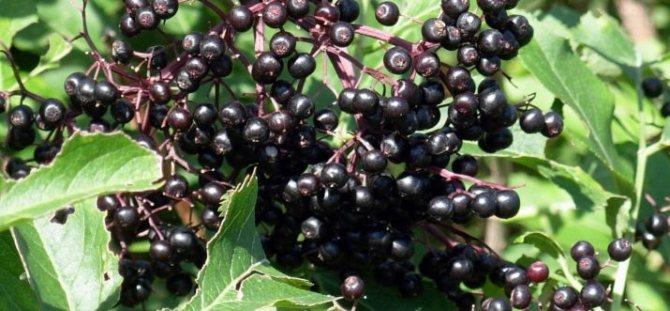

Aronia
Another name for this tree is mountain ash. It can be red-fruited and black-fruited. A new species - purple chokeberry - appeared quite recently and has not yet had time to reach the masses. The large, astringent berry is able to normalize blood pressure.
Its use is also useful in diseases of the thyroid gland, as well as in irradiation. In addition, black fruit can be used to make wine and other delicious drinks.
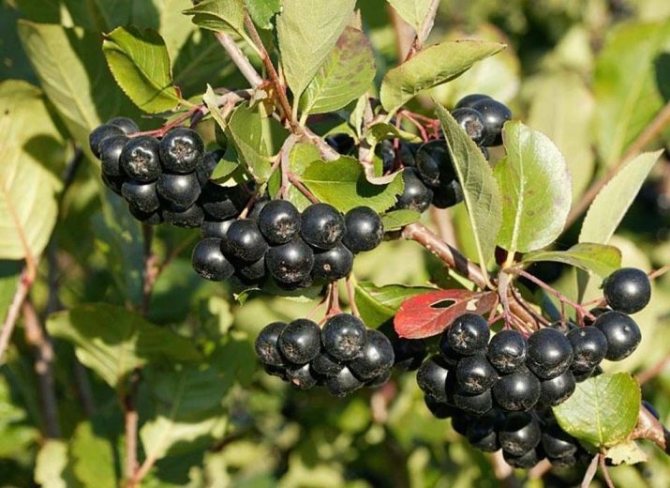

Barbados cherry
It is also called acerola cherry. Especially popular in Central America and Western India. From cherries, you can get juice that has an amazing taste and aroma. Berries contain a huge amount of vitamin C, in comparison, they have about 60 times more of it than oranges.
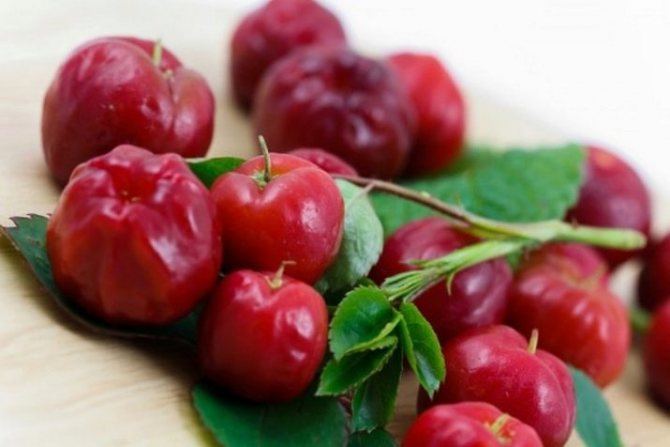

Canadian arrogance
Birds especially love to feast on this berry. The fruits are rather small, black with a blue tint.
Acai is widely known in Brazil. It is an excellent antioxidant. The berries are round, small in size. Most often it is used to prepare various types of drinks.
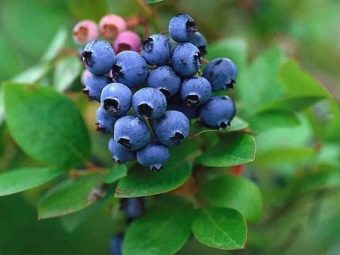

Virginia bird cherry
Before the berry ripens, it has a bright sourness and a pronounced tart taste. At the time of ripening, the fruits darken and become a little sweeter. It is used mainly for the preparation of canning, but it is necessary to add a lot of sugar. It can be found both in summer cottages and in the city.
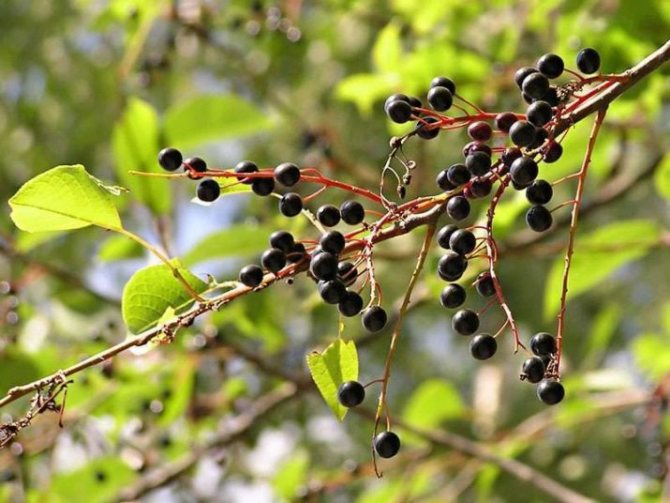

Black raspberry
The taste of black raspberries practically does not differ from red. The berries are not sugary, but they are quite sweet. They have a pronounced aroma, which is not affected even by heat treatment. According to experts, the content of ellagilic acid in fruits can prevent the development of malignant tumors. Therefore, they are often recommended to be used to prevent the formation of cancer cells.
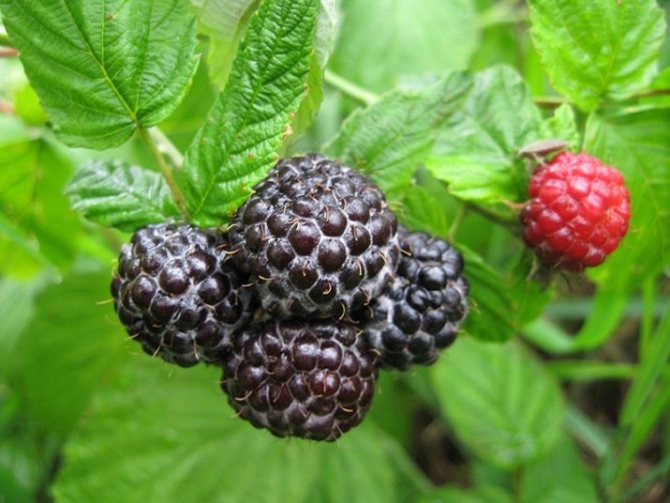

Black currant
If you do not know that there are hundreds of currant varieties, you might think that they are all the same. However, this is not at all the case, work on the development of new hybrids does not stop at the present time. These bush fruits grow in clusters, have a pleasant taste and delicate smell. The huge concentration of nutrients and vitamins makes currants one of the most popular garden shrubs that can be found in villages and garden plots.
Currant is famous for its choleretic, diaphoretic, diuretic effect. It can be taken to strengthen the body as a whole, used as an antiseptic. In addition, the berries have hemostatic properties.
Like raspberries, currants can be used to prevent cancer. Aromatic and tasty juices, preserves and jams are obtained from the fruits.
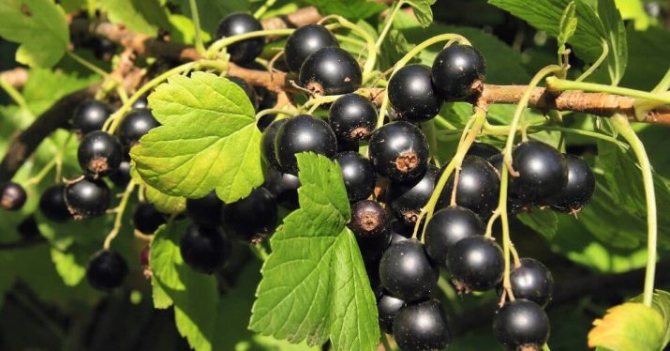

Honeysuckle
Honeysuckle contains many useful substances, such as magnesium, calcium, vitamin C and others. Many adults and children know oblong berries of black color with a bluish bloom. Even in ancient times, the fruits were used in medicine. The "Curly honeysuckle" variety is very popular now.
It should be borne in mind that some varieties of honeysuckle have a small amount of poison in the berries, so it is best to grow the berry yourself or buy it in reliable stores. Unknown forest fruits can cause poisoning.
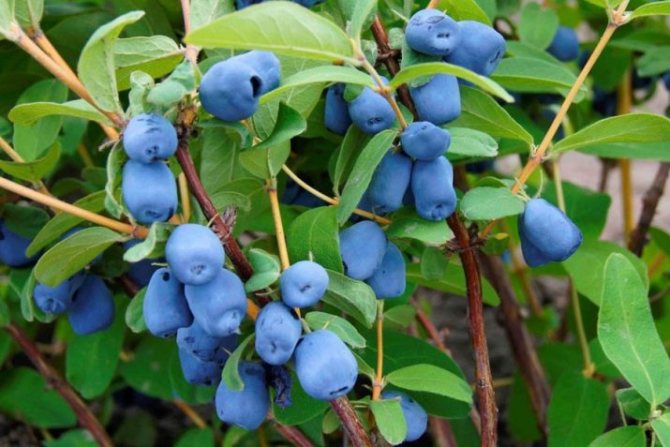

Blackberry
Blackberries, like raspberries, have a huge range of useful properties. It contains a huge amount of vitamins and minerals. In addition, the berry contains organic acids. Due to this, it not only helps to strengthen the body as a whole, but also helps with various diseases. The fruits have anti-sclerotic properties, help to normalize blood sugar levels, and saturates with useful elements.
As for an adult plant, it can reach 1.5 meters in height. In the spring, blackberries please with large white flowers. Berries with a pleasant sourness, rather large in size, but this indicator directly depends on the variety.
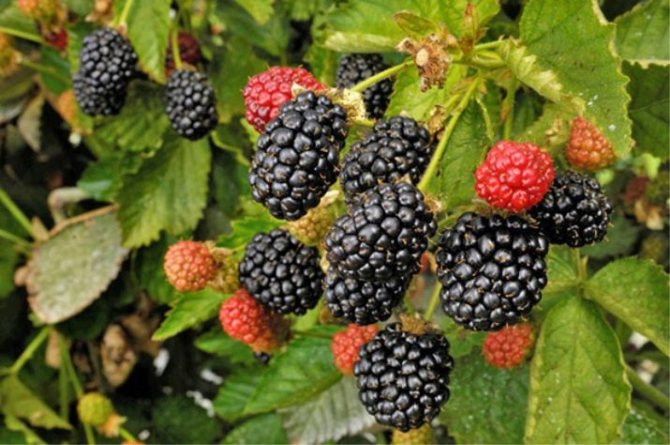

Black mulberry
A plant of the mulberry family. Its leaves are tough and have a jagged border. Fruits can be deep purple or almost black in color. Mulberry is especially common in the southern territories.
The berry is loved for its pleasant taste and extraordinary juiciness. They can be used to prepare various products and preservation, for example, jams, doshab, sherbet. The health benefits are expressed in a general strengthening effect, increased blood formation, normalization of metabolism. Mulberry fruits are advised to be consumed by people suffering from overweight, as they tend to dull appetite. Men speak of them as a product that has a beneficial effect on increasing potency.
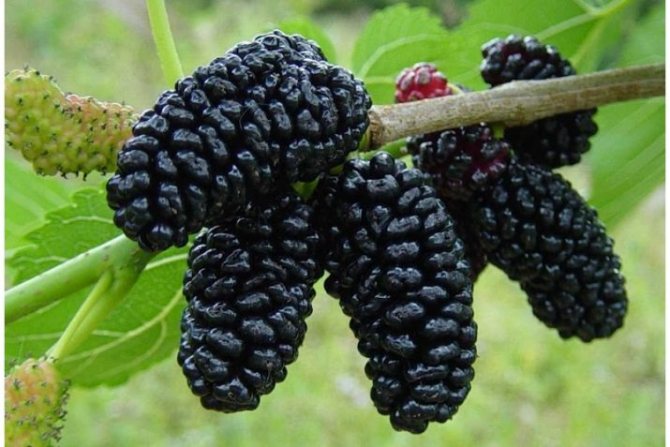

Blueberry
This shrub is often found in swamps and grows up to 40 centimeters in height. Leaves are elongated, saturated green. The berries have a red juicy pulp. Fresh blueberries are very useful, but this does not interfere with using them for preservation.
The fruits contain a huge amount of useful elements. In addition, they contain polyphenol, which has a beneficial effect on the restoration of brain cells. To improve vision and fight other eye diseases, doctors often prescribe drugs that contain this berry.
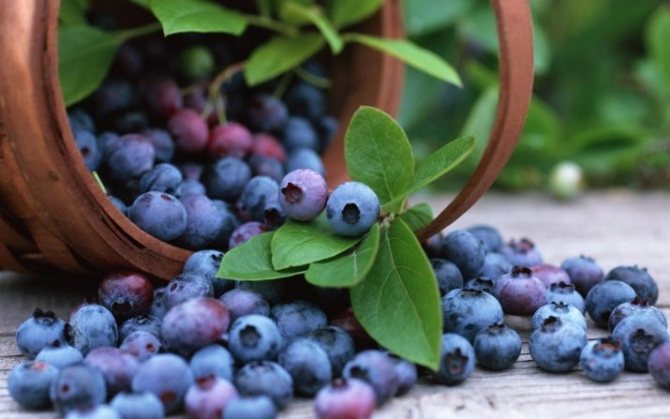

Blueberry
Most often, blueberries grow in northern latitudes. This is due to its high frost resistance. The shrub is small, capable of growing up to a meter. Berries with a blue tint. The main problem is considered to be the inability of the berry to withstand long distance transportation.
Therapeutic qualities of blueberries
The benefits of this blue berry are invaluable. The list of the therapeutic properties of blueberries can be summarized as follows:
- Promotes hematopoiesis.
- Regulates blood sugar and cholesterol levels.
- Improves memory and the process of memorization itself.
- Strengthens the heart muscle and blood vessels.
- It has a positive effect on brain activity.
- Relieves eye strain, slows down age-related decline in vision, improves its acuity (because it contains beta-carotene and retinol).
- Prevents constipation and diarrhea.
- Has antimicrobial effect.
- It has a positive effect on the work of the digestive tract: it improves digestion, promotes the formation of gastric juice.
- Improves the work of the pancreas.
- Helps eliminate edema.
- It has a good effect on the female body, helps to alleviate the condition with cystitis.
- Normalizes metabolism.
- Slows down the aging process.
- Minimizes the risk of developing Alzheimer's disease.
- Strengthens the nervous system.
- Helps to recover faster from previous illnesses.
But all the wonderful properties of the blue berry are manifested if it is present in the diet on an ongoing basis.
List of poisonous fruits
If you went for a walk in the forest and came across a bush or tree with appetizing black berries, you should think about it. Indeed, among the fruits, those can also be caught that are not only capable of harming the body, but also in special cases can be fatal. You need to know poisonous berries and be able to distinguish them from others, tasty and healthy.
Maiden grapes
This plant can be found throughout Russia. Outwardly, it very much resembles grapes that are grown in garden plots. You can only distinguish it by trying it.
The taste of maiden grapes is very unpleasant, with a noticeable astringency. You can determine it from the first berry. It must be said that a small dose will not do harm, in order to get poisoned, you need to eat a large amount of fruits.
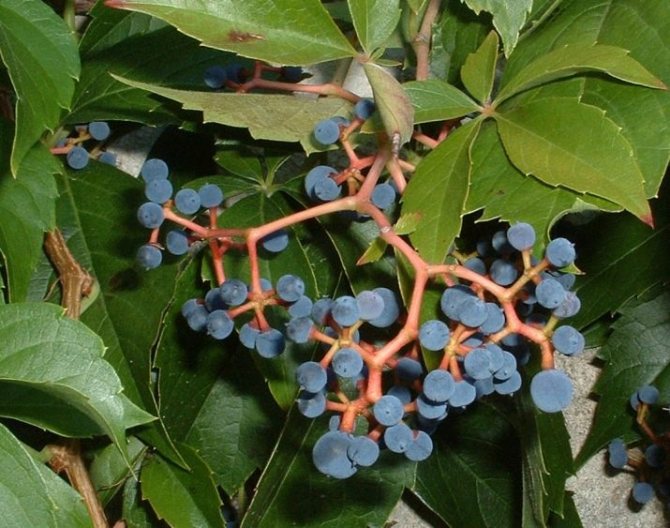

Nightshade
These bushes can often be found in the forest. The berries are like a small pepper, they taste very bitter. The plant is highly poisonous and can cause serious harm to the body.
Buckthorn fragile
Outwardly, the plant is very similar to bird cherry, so you should not risk it if you are not ready to accurately identify the bush. Berries with two, rarely four seeds are very poisonous, they cannot be eaten.
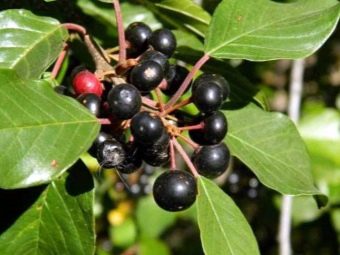

Wolf berries
Another plant that can be confused with bird cherry. However, the fruits on the wolf berry appear only in the fall. If, through negligence, they are eaten, a person will suffer severe weakness, diarrhea and convulsions will appear. With a large amount of eaten berries and untimely treatment, a lethal outcome is possible.
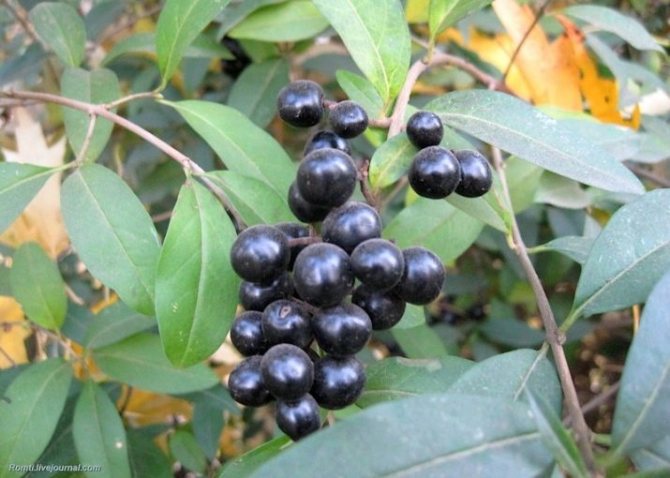

Spiky raven
These berries can also be confused with bird cherry or mountain ash. But at a close distance from the plant, you can feel a pronounced unpleasant odor. The fruits of the plant are collected in clusters and can be black, red and white. They are very poisonous, when ingested, they cause inflammation of the mucous membranes and intestines.Skin contact leads to blistering.
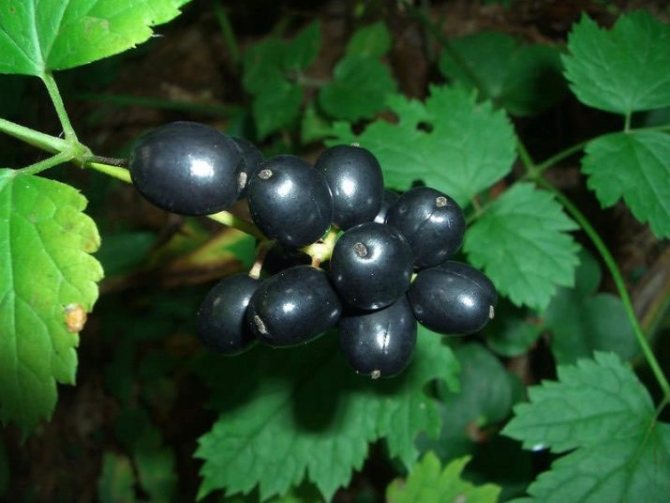

Lakonos
This plant can grow in close proximity to garden areas. Inflorescences resemble spikelets in shape. It has black berries with a purple tint, which are poisonous enough and can lead to health problems.
Raven eye
The plant is small in size, has 4 leaves located on the stem. Visually, it looks like a cross. At the base there is one black berry, which may have a bluish bloom. Ingestion causes vomiting, diarrhea and dizziness.


Belladonna or belladonna
These berries are very tricky. They have an attractive appearance and are also very sweet in taste. However, belladonna is dangerous even in small quantities, as it can cause respiratory arrest, which is fraught with death. Before this, the person begins to darken in the eyes, a burning sensation appears in the mouth, and the heart jumps out of the chest. If the poisoning is severe, it is accompanied by convulsions.
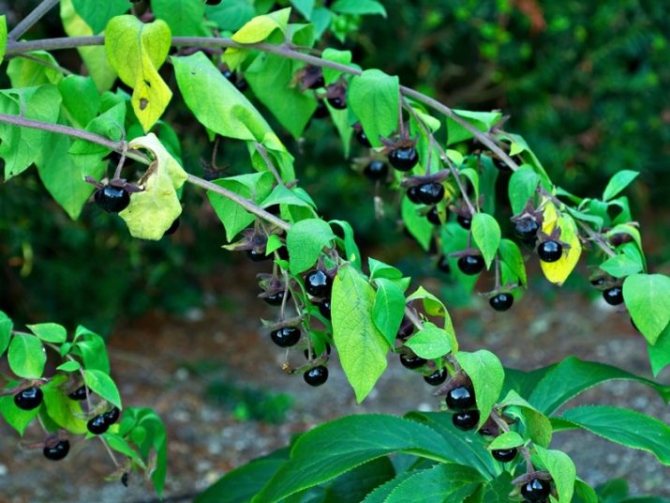

Biological description [edit | edit code]
Yoshta is a perennial berry bush. Bushes are powerful, spreading. They grow rapidly, forming shoots 1.5 m high or more. Unlike gooseberries, they do not have thorns. On average, a fruiting bush consists of 15-20 large branches of different ages. The crown diameter is about 1.5-2 m. The root system lies at a depth of 30-40 cm.
The leaves are dark green, large and shiny, without a pronounced currant aroma. Fall late in the fall.
The flowers are large and bright.
Berries are black with a purple tint. Usually collected in a brush of 3-5 pieces. They are distinguished by a dense skin, and they are similar in size and shape to cherries. The taste is sweet and sour, with a pleasant nutmeg aftertaste. The average fruit weight is about 3 g, although individual berries can reach 5 g. When fully ripe, they do not crumble.
The peculiarity of the plant is resistance to some diseases and pests. Resistant to winter frost. Life expectancy is about 20-30 years.
Yoshta is widespread in Western Europe.
Black berries attract children and adults not only with their bright and unusual color, but also with a pleasant taste. However, at the same time, it is not always possible to determine what kind of fruits we have in front of us, respectively, there is no idea about their properties. This can be dangerous, since there is no guarantee that the chosen berry will not turn out to be poisonous.
Ornamental plants
Among the most popular ornamental plants with black berries, two are the most common. We are talking about black elderberry and black honeysuckle. Let's talk about them in more detail.
Elderberry black
This plant is a shrub. It grows mainly in the southern latitudes and in the central part of our country. Bushes can grow up to 6 meters, and if they are not looked after, they will quickly spread throughout the site. However, with the proper complex of agrotechnical measures, elderberry looks quite impressive and can well be used to decorate plots and front gardens.
The bushes are covered with black berries, which ripen in August and September. In appearance, these are drupes with a blue tint, the diameter reaches 7 millimeters. The fruits contain very valuable useful elements such as vitamins, anthocyanins and oils.
The seeds are poisonous; when they enter the stomach, they break down, forming hydrocyanic acid, which can become very dangerous for human health. Therefore, only the pulp can be eaten.
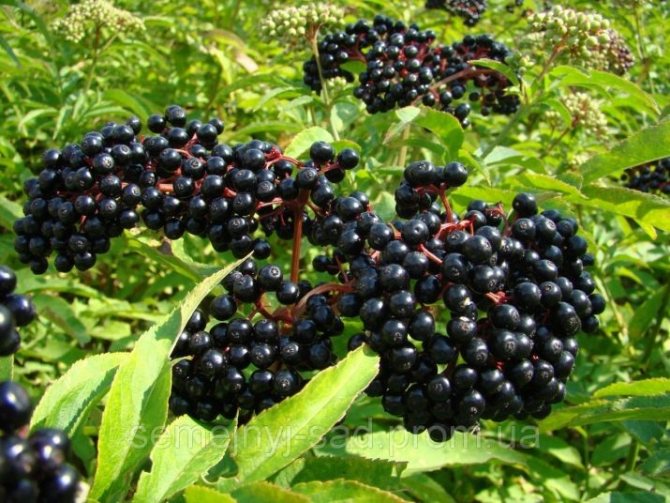

Black honeysuckle
This is another fairly large shrub. It can be over 3 meters long. Most often, honeysuckle grows in the eastern regions of Russia, but you can find it in other regions as well. The plant tolerates a strong drop in temperature, therefore it easily survives winters, and it is also not afraid of frosts during the flowering period, so honeysuckle can be grown even in northern latitudes. In addition, it is completely undemanding to the type of soil, withstands attacks of pests and is not afraid of many diseases, which makes it a real decoration of any site.
The plant has rather large fruits, elongated in shape. The length of one berry is approximately 2 centimeters. Honeysuckle ripens early, the first fruits can be harvested at the beginning of summer.As for the taste, it differs with a slight sourness, but this does not spoil it at all. Even small children love berries.
Of the fruits of honeysuckle, preservation is most often made, but it is very useful to use them fresh. The bush gives the first harvest a few years after it was planted in a permanent place.
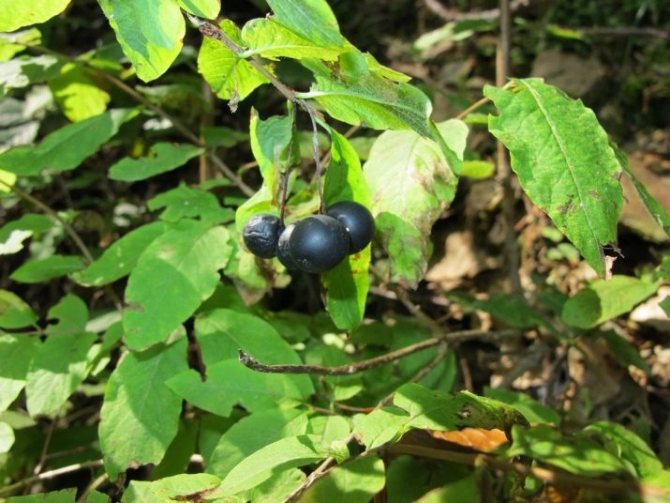

For another edible berry - black nightshade, see the video below.
Most black berries not only look beautiful, but also taste good. We do not always know their names, and at the same time their possible properties. In this kingdom there are representatives that are quite valuable to humans. Although there are poisonous ones that are harmful to health.
Elderberry red
Walking in the second half of summer along the edge of the forest or in the park, you can see a spreading shrub decorated with lush berry clusters. This is an elderberry. Just don't confuse it with edible black.
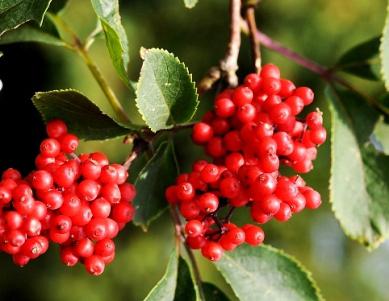

This kind of elderberry does not mean at all that it has not yet ripened. It's just a completely different species of the same plant family. The red elderberry is very beautiful, so it is readily cultivated to decorate alleys, parks and squares. Its berries are a bit like rowan brushes, but the leaves and the plant itself are completely different. Birds eat its red berries with pleasure, but for humans they are poisonous due to the presence of amygdalin in them, as it turns into hydrocyanic acid in his stomach. In small doses, traditional medicine suggests using the berries of a red elderberry as a medicine. Important: it has already been proven that red elderberry does not save you from cancer.
What fruits can be called berries
Long ago, when scientists decided to classify fruits, they forgot about the existence of berries. Later, the existing classification was revised. This resulted in confusion. Not many people know and understand the differences between them.
There are a couple of concepts that differ fundamentally: scientific and common people. Among the people, it is customary to call berries not large, round fruits in which there is no stone, having a bright color, with a juicy sweet or sweet-sour pulp. The scientific method of separation is not taken into account in this case.
In addition, the berries are taken with two fingers - the index and thumb. They are eaten whole or by handfuls. It is possible to collect them on the bushes or find them among the grass. Rowan and bird cherry - on tree branches. With the help of three fingers or the palm, take the fruit.
According to the scientific division, it turns out that gooseberries and currants belong to the group of berries. Rosehip, strawberry, wild strawberry - false berries, cherries and cherries are referred to as drupes.
Scientists have complicated things. The organ of a plant formed from the ovary and containing seeds or a bone, only one, is usually called a fruit.
Cultivated trees
It is assumed that if the text mentions a certain fruit growing on trees in our world (apricot, pomegranate, etc.), then a corresponding tree exists in Martin's world.
|
|
Fiery plum
(English fire plum) is a genus of garden plum, widespread in the south. [thirty]
Beneficial features
No matter what types scientists divide the fruits into, their benefits are important. The body is favorably influenced by the biologically active substances present in their composition. Traditional medicine advises to use berries for food during the treatment of various pathologies.
In their composition, they contain carbohydrates in the form of glucose and fructose. Pectin, which removes pathogenic microflora and toxins from the body. In addition, they contain various trace elements - silver, molybdenum, manganese, nickel, cobalt, zinc, copper, potassium, boron, calcium, iodine, magnesium.
A small berry is an environmentally friendly product, without any chemicals, full of vitamins. There are very few proteins and fats.It follows from this that they cannot be called an energy source.
Blueberry
The name of the blue berries hints at a different shade, but this is not the case. You can verify by looking at the photo below.
Blueberry is a low-growing shrub, whose name comes from the Latin word vacca, translated as "cow" (the leaves were fed to livestock).
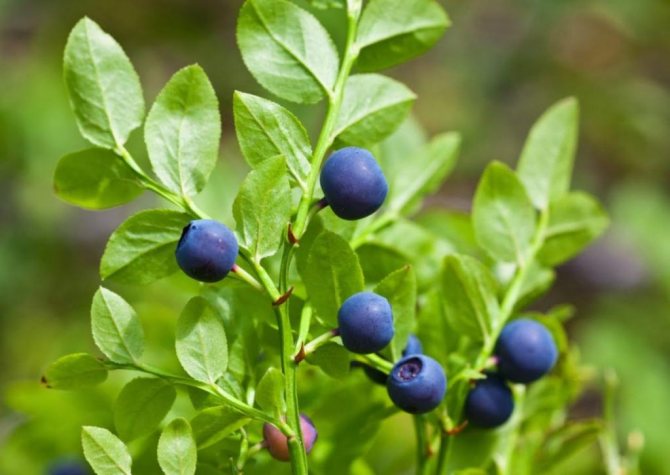

There are many varieties, the most famous are highbush (a lot of fruit, often used for decorative purposes) and lowush (very sweet berries).
The composition of this blue berry is impressive, as is the case with blueberries. It contains vitamins (PP, E, C, B2, B1), calcium, iron, magnesium, phosphorus, potassium, polysaccharides, tannins, organic acids, flavonoids, antioxidants, fatty acids, monosaccharides.
Despite the fact that the berries are very sweet, there are not very many calories in them - only 44 kcal per 100 grams.
What is what
Berries are the fruits of tomatoes and eggplants.
Drupes are the fruits of stone fruit plants - peaches, cherries, apricots, plums, sweet cherries.
Polystyrene - referred to as complex, consisting of connected small drupes - raspberries, blackberries.
False berries include fruits growing on rose hips, wild strawberries, strawberries. It does not matter that strawberries have a lot of grains and juicy flesh - they are not a berry. After all, the small seeds that are on it, in their essence, are tiny nuts - the real fruits of strawberries. Considering everything, it is referred to as multi-roots.
When the "berry" is formed, the ovary and receptacle are involved, which have grown, contributing to the formation of juicy pulp.
In this regard, strawberries are classified as false berries. Rosehip nuts are located inside. He is also ranked among the false representatives of the species.
Juniper
The name of the blue berry growing on a coniferous tree is easy to remember. Because this is a unique plant! Juniper fruits in the amount of 35 grams fully cover the daily need of the human body for vitamin C.
Monosaccharides account for about 40 percent of the composition, the rest is phytoncides, essential oils, organic acids, as well as chromium, iron and manganese.
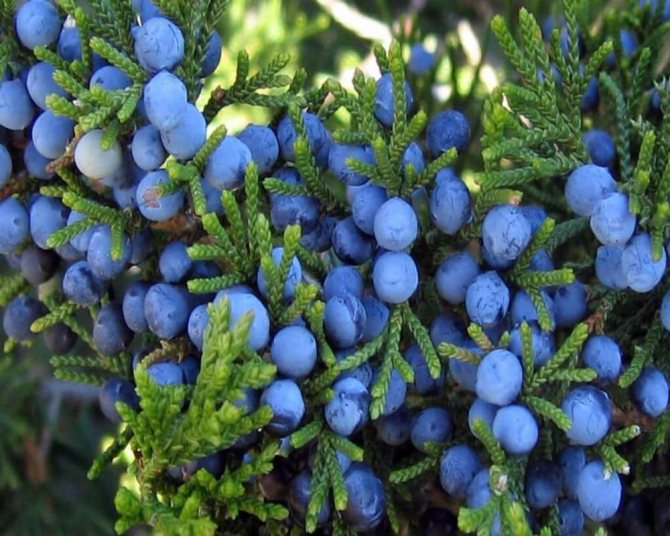

You can eat up to 100 grams per day, dividing this amount into two doses. You don't have to worry - the blue berries, the photo of which is presented above, are absolutely edible. They have a pleasant, slightly bitter taste with a rich shade of needles. They can also be used as a seasoning, and can also be added when salting meat.
The difference between edible forest berries and inedible ones
The appearance of the conceived does not allow to distinguish harmful from useful. Animals and birds do this without much difficulty. Pay attention to whether there are berries under the crown of a tree or under a bush that the animals were eating. This sign indicates that they are quite edible and not poisonous.
After trying one of the berries, do not rush to eat the next one. After all, their taste can also help in determining the edibility of the fruit. Bitter and tart ones are usually poisonous. Not poisonous - juicy, have a pleasant taste.
The most poisonous are small round fruits, with a shiny smooth surface, with a red or black color. They are always distinguished by their attractiveness. To be sure that they are not poisonous, you need to carefully study and remember the appearance and names of useful forest berries. Photos will help with this.
Arum
The outward appearance of the flower, this plant resembles a calla, only its cover is not white, but dirty-green-lilac, similar to decaying meat. The smell is about the same. The plant needs this to attract carrion flies and dung flies - its only pollinators. But the fruit of the arum is quite pretty.
On an erect leg, its bright, shiny red berries look unusually attractive.The photo shows that they form something like a cob and look like beads stuck to one another. They are poisonous only when fresh. Dried berries are used in folk medicine to treat bronchitis, hemorrhoids and some other diseases. Arum grows almost throughout Europe and Asia. It can be seen on river banks, meadows, pastures, in thickets of bushes and on rocky mountain slopes.
Healthy black berries
We offer a short catalog of edible garden and forest black berries with descriptions and photographs. In the garden or in the forest, black berries can be found on the branches of trees - chokeberry, shrubs - currants, honeysuckle, and on herbaceous plants - blueberries, blueberries.
Elder
The fruits have antioxidant properties, are able to lower the concentration of cholesterol, improve vision, strengthen immunity, and improve the state of the cardiovascular system.
They will help cure coughs, colds, flu, tonsillitis, fight bacteria and viruses.
Aronia
Aronia in nature is represented by two varieties: chokeberry and red-fruited mountain ash. Today, purple chokeberry is known, which is a hybrid obtained by crossing red and black mountain ash.
Its berries are used in the manufacture of jams, juices and jams.
Barbados cherry
This plant has several other names: naked malpighia, acerola cherry. It grows in Central America and the West Indies, where juice from its berries is very popular. The fruits of this plant contain 65 times more vitamin C than oranges.
Canadian arrogance
The fruit is a drupe, blue-black. Usually birds feed on them.
Small, round, black berries are one of the main commercial crops in Brazil. It is used to make a variety of drinks. Their antioxidant properties have been known for a long time.
Virginia bird cherry
Unripe fruits with a red color are sour and tart. When they ripen, they acquire a dark color and become less tart.
Syrups, jam, jelly are prepared from them, but this requires a large amount of sugar or its substitute.
Black raspberry
Berries with a classic sweet taste, without cloying. The raspberry aroma is not lost during heat treatment. The fruit contains ellagic acid, which helps prevent the growth of cancer cells.
This makes the fruit of the bush an effective preventive measure to prevent the development of cancer.
Black currant
The shrub has black, pleasantly smelling berries, which outwardly resemble the fruits of red currants. Used in the manufacture of jams, pies, ice cream, cakes.
Vitamin C is contained in a huge amount. In addition, they contain iron, vitamin B5, phosphorus, potassium.
Honeysuckle
The fruit contains: vitamin C, potassium, calcium, magnesium and quercetin - successfully eliminating free radicals. For centuries, honeysuckle berries have been used in recipes by Chinese healers. Some of the varieties contain poison, so its fruits should be purchased in stores or grown on your own site than plucked in the forest.
Blackberry
Eaten blackberry fruits contribute to the normalization of metabolic processes in the human body, increase immunity. Infusions and decoctions made from roots and foliage help with wound healing, have an astringent and anti-inflammatory effect.
The height of the plant sometimes reaches 1.5 m. In spring, the bushes are decorated with large white flowers. The berries are similar in shape to raspberries, but they are black in color, covered with a bluish bloom, with a sour-tart taste.
Black mulberry
Belongs to the mulberry family.
It has hard leaves with small teeth along the edge. Fragrant and juicy berries of dark purple or almost black color. Jam, syrups, jams are prepared from them.
Blueberry
The fruits of this plant help to improve vision, strengthen the walls of blood vessels, and are used to prevent diabetes.
Wetlands are a favorite habitat. The plant is a shrub. Its height reaches 40 centimeters. Elongated leathery leaves. The fruit has a sweet red pulp. They are usually eaten fresh, but they are also prepared in the form of jam or jam.
Blueberry
In the treatment of gastritis and enterocolitis, fruits and leaves are used. In addition, they have antipyretic, vasodilating and anti-inflammatory properties. The bush is about one meter tall, the berries are bluish in color.
It is found in the northern regions and is frost-resistant. Collecting blueberries is difficult because it does not tolerate transportation well.
Crowberry
Well-branching creeping shrub. Its height does not exceed 20 centimeters, and the length of the lashes can reach one meter. Grows in swampy areas. Stores very well without any special treatment.
Berries have the richest chemical composition. They are used in the treatment of nervous disorders, headaches, liver and kidney diseases.
Juniper
The fruits of the juniper are called cone-berries, which, when ripe, turn from green to black-purple, covered with a waxy coating. Rich in trace elements, essential oils.
Honeysuckle
This name brings together about two hundred plants of various species. However, now we will only talk about edible honeysuckle - these are large blue berries with a sweet smell and an unusual shape.
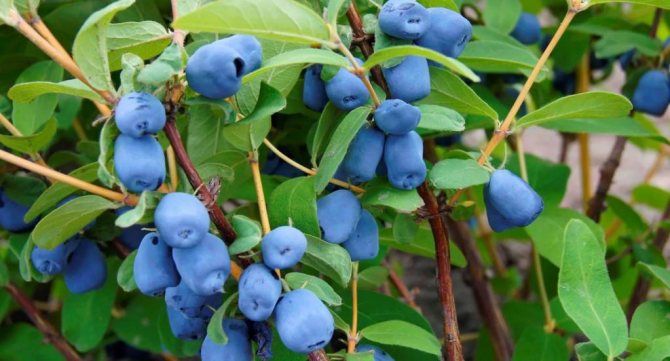

It contains beta-carotene, vitamins C, B1, B2 and A, potassium, iodine, phosphorus, iron, copper, aluminum, sodium, manganese, magnesium, pectin and tannins, sucrose, fructose and organic acids.
Poisonous forest berries
While walking through the forest, you need to remember that not all of the berries have beneficial properties. Among them, there are often those that can harm the body and cause severe poisoning or even death.
Maiden grapes
Outwardly, the plant looks like home grapes. It is widespread throughout Russia. It has small berries that can easily be mistaken for regular grapes. They have a pungent, astringent and unpleasant taste. These signs will help you identify it.
To harm your health, you need to eat quite a lot of berries.
After trying just one and realizing that this is an inedible girlish grape, do not panic, but simply do not eat anymore.
Nightshade
Low herbaceous bushes, often found in the forest. The berries of the plant resemble small tomatoes or peppers. They have a sweet and bitter taste. They are highly poisonous. Cannot be used in food under any pretext.
Buckthorn fragile
This shrub resembles a bird cherry. Buckthorn fruits are poisonous.
Spiky raven
The berries of the plant are colored black, vaguely similar to the fruits of bird cherry and mountain ash, have a sharp, unpleasant odor, and are poisonous. The juice provokes inflammation of the mucous membrane of the oral cavity and intestines. Juice on the skin will cause watery blisters.
Lakonos or American phytolacca
The plant is found not only in the wild, but sometimes in the adjoining areas. It has powerful inflorescences that resemble ears and black-purple berries, which contain many harmful substances that can harm the human body.
Common privet
The fruits of this plant can be confused with bird cherry. In common people they are called "wolf berries". You cannot eat them - they are highly poisonous.
Raven eye
It is a short plant with only four leaves on its stem. Their arrangement resembles a cross. In the place where the leaves grow together, there is only one berry, it is black. You can't eat berries, because it's dangerous.
Belladonna or belladonna
Large and shiny berries are insidious. They taste sweet.But a couple of berries eaten can lead to respiratory arrest and death.
Marsh calla
This very beautiful graceful plant is commonly known as calla. It is happily grown in flower beds, used in bouquets. In nature, calla can be found where there is sufficient moisture. It grows in the European part of Russia, Siberia, and the Far East. All parts of it are poisonous. Calla's flowers are small and inconspicuous, collected on the cob. They are decorated with a white veil, taken by many for a large petal.
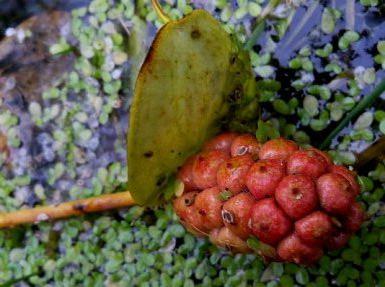

The fruit of the plant is a red berry, somewhat reminiscent of a large mulberry on a leg. Calla juice causes irritation and inflammation of the skin, and when it enters the stomach, nausea, vomiting, convulsions, and irregular heartbeats appear. Often pets are poisoned with the leaves and fruits of calla lilies. They begin to salivate profusely, tremble, abdominal distention, pulse becomes very weak, but frequent. Death without urgent action occurs within an hour. For medicinal purposes, calla rhizomes are mainly used, they are added to some dishes even after special treatment.
First aid for poisoning with poisonous fruits
Call an ambulance. And before she arrives, you need to cleanse the stomach.
Vomiting that occurs during poisoning is a protective reaction of the body. It helps to get rid of poisons. If vomiting is absent, it must be induced or the stomach washed out.
The simplest way is to drink 1.2-1.5 liters of warm water with the addition of manganese. The solution should be slightly pink. You can also use boiled water with baking soda. Then induce vomiting. This procedure must be repeated.
Then give the patient activated charcoal, at the rate of 1 tablet per 10 kilograms of the victim's weight. Coal can be replaced with any other absorbent.
To completely cleanse the body of poisons, you need to make a cleansing enema or take a laxative.
At the end of these procedures, the victim must be wrapped up, if necessary, overlaid with heating pads. Drink hot sweet tea.
Useful information about edible and poisonous forest plants, we recommend that you carefully watch the video:
Black fruits on shrubs and trees are a mystery to many people. Most do not know their names, properties, and the ability to eat. Often, black berries are very tasty and healthy fruits. However, no less often you can find poisonous fruits, the use of which can lead to sad consequences.
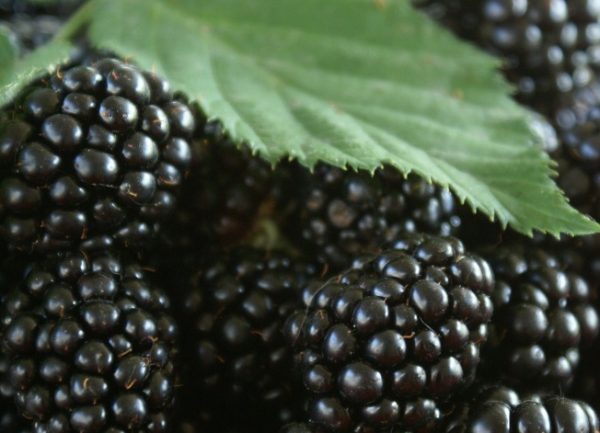

Lily of the valley
This delicate fragrant flower, which delights us in spring, is unusually poisonous. The fruit of the lily of the valley is a round red berry located on a stalk on thin, slightly curved stalks. Lily of the valley grows almost everywhere - in deciduous, coniferous and mixed forests, in oak forests, in gardens and flower beds. He especially likes the edges and glades with a fairly moist soil.
The berries stay on the plant for a long time. They are especially dangerous for animals. People are rarely poisoned by them. The poison contained in all parts of the flower is called konvallatoxin. Once in the body, it can cause cardiac arrest. Those who have eaten a small amount of berries have all the signs of food poisoning. It is noteworthy that even the water in which the lilies of the valley are standing becomes poisonous. But in strictly fixed doses, the plant is used in official medicine to treat heart disease. Traditional medicine uses lily of the valley much more widely, for example, for rheumatism, headaches, eye diseases.
Types of berries and their beneficial properties
As a rule, berries contain a lot of useful microelements (carbohydrates, nutrients) and are recommended for use in the treatment of various diseases.
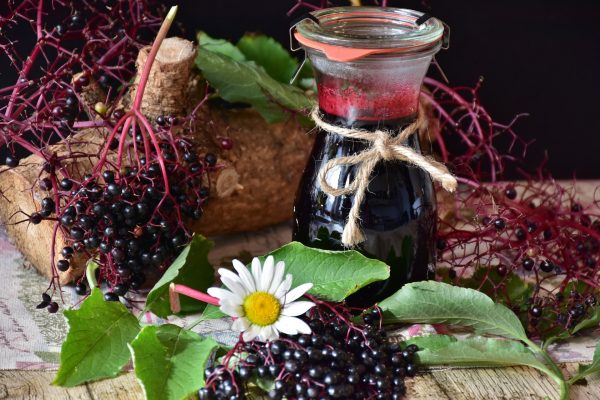

According to the generally accepted classification, berries are divided into the following types:
- berries;
- apple - in addition to apples, it includes pear and rowan fruits;
- pumpkin - those fruits that grow on melons, pumpkins, zucchini;
- orange is a citrus fruit.
How to tell an edible wild berry from an inedible berry
In appearance, it is very difficult to distinguish such berries. However, there are a number of signs to watch out for:
- Poisonous berries are most often bitter in taste, not poisonous have a pleasant taste, juicy;
- Before trying a berry, you need to carefully consider the space next to a shrub or tree. If there are traces that the berries were pecked by birds, then there is a high probability that they can be eaten;
- Poisonous berries, as a rule, are small, have a shiny surface and a red-black color.
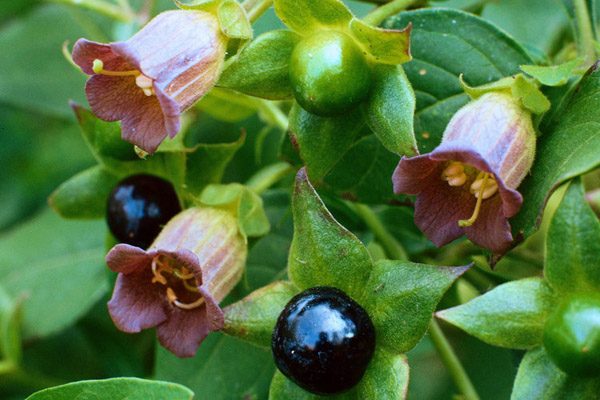

Euonymus
Probably, many will be interested in the name of a very unusual red berry - bright, juicy, with black dotted eyes. It is a warty euonymus. Its fruits have a rather pleasant taste, so they are eagerly pecked by forest birds.
People, seeing this, might think the berries are safe. But euonymus is poisonous, and all parts of this beautiful plant are dangerous. Symptoms of poisoning with attractive berries are nausea, vomiting, diarrhea, convulsions, general weakness, heart failure. Euonymus grows in deciduous groves, forests, loves oak forests and places with lime-rich soils. In settlements, it can be seen in the form of a spectacular hedge.
Poisonous forest berries
When walking in the forest, it is very important to be able to identify berries that can be harmful to the body, cause intoxication, and in some cases, death.
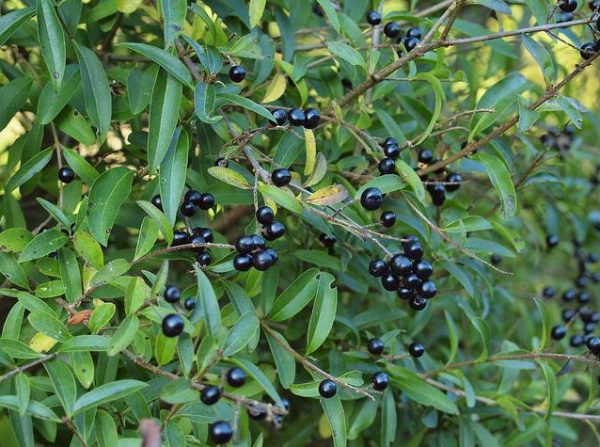

Here are the main representatives of such berries:
- Girlish grapes - they look like homemade. Fruits in small berries with a sharp and tart aftertaste. Minor use will not harm, but it will not add benefits either;
- Nightshade - berries that resemble a small tomato. They grow on grassy bushes, it is strictly forbidden to eat, they are poisonous;
- Buckthorn brittle - looks like bird cherry, is poisonous, it is forbidden to eat;
- Spike-shaped raven - has a similarity with mountain ash and bird cherry. When used, it inflames the mucous membrane of the human body, when it comes into contact with the skin, it causes watery blisters;
- Privet ("wolf berries") - black berries, similar to bird cherry, grow on bushes. Strongly poisonous, it is forbidden to eat;
- Belladonna is extremely poisonous and can be fatal if consumed.
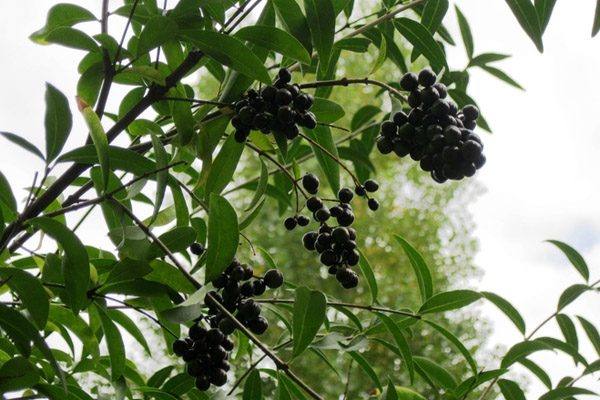

Irga
Another small blue berry that deserves attention. They are not very popular - irgu is grown only by enthusiastic gardeners, since the plant does not always take root.
100 grams of fruit contains 44.4 percent of the daily value of ascorbic acid. Even in Irga there are previously not mentioned flavonols and phytosterols.
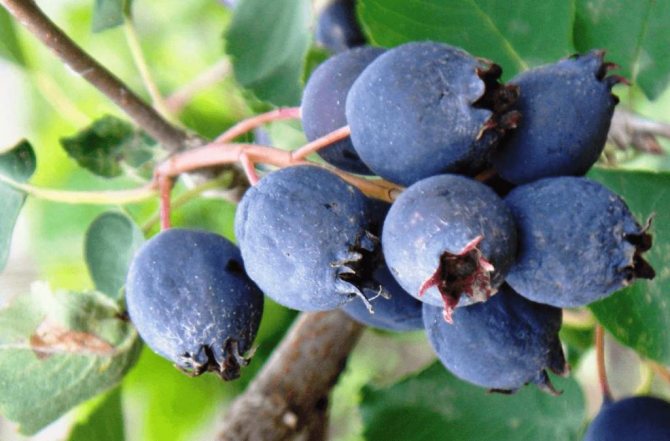

This blue berry has anti-inflammatory, tonic, bactericidal, cardiotonic, wound healing, tonic, hypotensive and astringent effects.
Not only fruits are useful, but also flowers. The funds made from them help to eliminate heart failure and normalize hypertension. And the bark is used in the treatment of gastrointestinal problems, burns and purulent wounds.
Inedible berry poisoning: signs and treatment
The main signs of poisoning with inedible berries include the following:
- Rapid pulse, dizziness, malaise;
- abdominal pain, nausea, vomiting, upset;
- convulsions.
If such signs appear in a person, it is necessary to call the rescue service, and before its arrival, try to provide first aid to the victim. First of all, it is necessary to induce vomiting in order to cleanse the body from the effects of poisons. After that, take tablets of activated charcoal (1 tablet per 10 kg of human weight) or other absorbent. It is also recommended to take a laxative to completely cleanse the body of the poisonous substance. After that, the victim is wrapped up and sealed with sweet hot tea.
